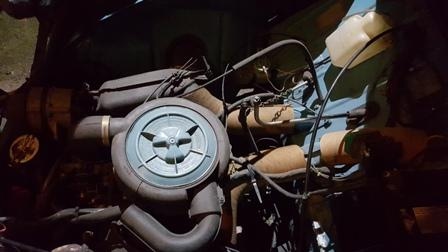by Don Our Citroën 2CV (French: "deux chevaux" i.e. "deux chevaux-vapeur" (lit. "two steam horses"), was a sensation when I drove it to lodge rehearsal recently. We have owned it, an original Lagoon Blue colour built in 1982, for about 8 years. The car was designed in the 1930s before WW2 to help motorize the large number of French farmers still at that time using horses and carts. It is said that a design criteria was that it must be able to be driven at 50 kph over a ploughed field with a dozen eggs in the back without breaking any. However, the car was not introduced until 1948 and was produced until 1990. In total 15m were made. Originally the front doors were “suicide doors” and all doors could be slid off, the rear seat removed only being held by two bolts, and the fabric roof removed creating a utility car for French famers. 4WD versions were made with front and rear engines for French Army military service in the North African deserts. I was initially attracted by the car’s simplicity, design and innovations. Now an owner, I find it is fun to drive, has great road holding capability, fantastic cornering and ability to ride over bumps and holes in the road, easy to maintain, cheap to run and maintain with an abundance of spares available. It costs only $150 a year to have Club Registration allowing use for 90 days a year. James Bond liked them too: https://www.youtube.com/watch?v=CvJp1X3qiog For the technically minded it is four seat, FWD, powered by a two cylinder, horizontally opposed air cooled petrol engine (the efficient “boxer” design with a low centre of gravity, compact and facilitates the use of a short crank shaft - ours has the big motor with a 602 cc capacity The early engines were as small as 375 cc!), a full flow oil filter, a four forward and reverse fully synchronized manual gearbox with an “umbrella” type gear change, no distributor (we have fitted an electronic ignition – this reduces maintenance and overcomes an irregular spark caused by cam bearing wear) and a “wasted spark” ignition system is used, front inboard disk brakes to minimise the sprung weight - a feature of high class sports cars, a shroud around the exhaust manifold for saloon heating and the front and rear suspension on each side coupled through a damper to improve its ride and with a high ground clearance. It is simple and without the dead weight of a heavy radiator full of water and a rear axle and differential. It is light, with the body being made in the main of 0.7mm steel, the early models having their panels corrugated to increase their strength.Our car has been rebuilt on a new galvanized chassis, the engine cylinders and pistons, etc replaced, and the heads re-machined with new valves, springs and valve guides. The valves have hardened seats and as it has a high compression ratio, high octane unleaded fuel is used. It has a roller bearing crankshaft so it seldom if ever needs replacement providing oil is maintained in the sump. It can travel 100 km on about 5-6 litres of fuel depending on driving conditions and can easily cruise at 90 kph on the flat and much faster downhill with a tail wind, but it does not like hills much. The Citroën car club (CCOC) is great so if you want some fun, buy and drive a deux chevaux. There are over 100 cars registered in Victoria. |
|
|


